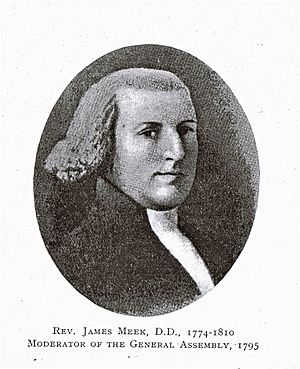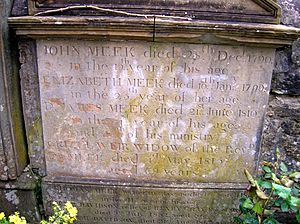James Meek (minister) facts for kids
James Meek (1742–1810) was a minister in Cambuslang, Scotland, from 1774 until he died. He was the leader of the General Assembly of the Church of Scotland in 1795. People remember him as a smart and modern church leader from the Age of Enlightenment. He wrote a detailed report about Cambuslang for the first ever Statistical Account of Scotland.
Contents
His Life Story
James Meek was born in Shotts, Scotland. His family, the Meeks, were small landowners, or lairds, who had owned land there since the 1600s. Some of his ancestors were even punished and lost their land for supporting the Covenanters, a group who fought for their religious beliefs. Their land was given back after the Glorious Revolution, when William of Orange became king.
James Meek decided to become a minister, following a family tradition. He studied at Glasgow University. This was a time when many famous thinkers of the Scottish Enlightenment were teaching there, like Adam Smith. James was very smart and even preached in the university chapel.
Later, in 1805, he became a member of the Royal Society of Edinburgh, which is a group for important scientists and thinkers. James Meek passed away in Cambuslang in 1810.
His Family
James Meek married Grizel Weir in 1770. They had two sons, John and Thomas, and two daughters, Elizabeth and Frances. Sadly, both sons and Elizabeth died quite young. Frances lived a long life, passing away at 88.
When He Became Minister in Cambuslang
In 1772, James Meek was chosen to be the minister of Cambuslang. This was decided by the Duke of Hamilton, which was allowed by a law from Queen Anne's time. However, many people in Cambuslang did not want him as their minister.
Only about a dozen people signed a paper supporting him. Others strongly disagreed, saying he had different ideas about faith than they did. They believed that only faith could make a person worthy in God's eyes. They also thought he relied too much on human reason and suggested that people could work with God for their own salvation. They even shared things they claimed he said in his sermons as proof.
James Meek denied all these claims. This started a long argument that went through the church courts.
Here are some of the things they accused him of saying:
- That our honesty is what makes God accept us.
- That people become bad by copying others, not because of Adam's first sin.
- That he invited people to church, no matter how bad their past actions, if they promised to do better.
- That our faith and honest efforts work together with Christ's goodness.
- That if faith goes beyond reason, it becomes just believing things without proof.
In 1774, the main church meeting, called the General Assembly, told the local church group, the Presbytery of Hamilton, to make him the minister. The local group looked into the objections and said they were silly and had no proof.
The people who objected then appealed to a bigger church group, the Synod of Glasgow and Ayr. This group told the local group to investigate more carefully. The local group still found no problems and even warned the objectors. The objectors appealed again, and this time the Synod sided with them.
The case then went back to the General Assembly in 1775. James Meek was even asked to preach to the King's representative, showing he was still highly respected. The Assembly discussed the case and decided to dismiss all the objections. They officially made James Meek the minister of Cambuslang.
His University Work
James Meek was a "Dean of the Faculties" at the University of Glasgow several times between 1780 and 1800. This meant he helped manage the different departments of the university. In 1781, the university gave him the special degree of Doctor of Divinity, which is a high honor for a religious scholar.
His Report on Cambuslang (1791)
James Meek wrote a very detailed report about Cambuslang for the first Statistical Account of Scotland. This report showed he was a careful scholar with many interests. He looked at old documents and talked to many people in the parish to write about what Cambuslang was like in the 1790s.
He compared life in 1750 to 1791, showing how things had improved. He gave exact prices for goods and clear descriptions of farming and industry. He also wrote about the big religious meetings that happened in Cambuslang in the 1720s. He looked at both sides of the story, wondering if the sudden conversions were truly supernatural.
He also wrote about the geology of the area and gave precise measurements for land, river sizes, and more. He even recorded weather measurements twice a day for seven years! These measurements were so good that people used them throughout the 1800s and even in the 1900s to study weather history and climate change. He also mentioned the beautiful view of the Clyde valley from a nearby hill.
His Weather Journal
James Meek kept a detailed weather journal from 1785 to 1809. It's a leather-bound book filled with his daily notes on temperature, wind, rainfall, and how the weather affected farming. At the end of each month and year, he summarized the weather and noted unusual conditions.
For example, his first entry on January 1, 1785, said, "Cloudy with some slight showers of snow." For that month, he noted 12 fair days and 19 rainy or snowy days. He also wrote about how cold it was, mentioning that people were skating on the Rhone river in France! But then, June was "a remarkably warm and pleasant month."
He kept these detailed records for almost 24 years. This journal is still used by modern historians who study climate change.
Church Leader
On May 21, 1795, James Meek became the Moderator (or chairman) of the General Assembly of the Church of Scotland. He was the only candidate and was chosen by everyone. The Assembly met for nine days, dealing with many important church matters.
They received a letter from King George III and congratulated him on his son's upcoming marriage. They also discussed the "Religious Education of Youth" and looked at the training of new ministers. As a church court, they settled arguments between different churches and ministers. They even discussed if barbers and hairdressers in Edinburgh were breaking the rules by working on Sundays!
Meek's Library
James Meek's personal library, which is now in the National Library of Scotland, shows that he was very interested in new developments like roads and canals across Britain.
Some documents he owned include:
- A paper about collecting money to build a bridge over the North-Esk river.
- A bill about fixing roads in Lanarkshire.
- A legal case about a tenant appealing a church decision.
At Glasgow University, there's a very old manuscript about the history of the Church of Scotland from 1560 to the 1630s. A letter from James Meek is bound with it. In this letter, he explains that the manuscript is very important because the original copy was lost in a fire. He also notes many corrections and improvements to the text, showing how careful and dedicated he was as a scholar. He believed his corrections made it a better and clearer historical record.
See also
| Church of Scotland titles | ||
|---|---|---|
| Preceded by Robert Arnot |
Moderator of the General Assembly of the Church of Scotland 1795 |
Succeeded by William Greenfield |



